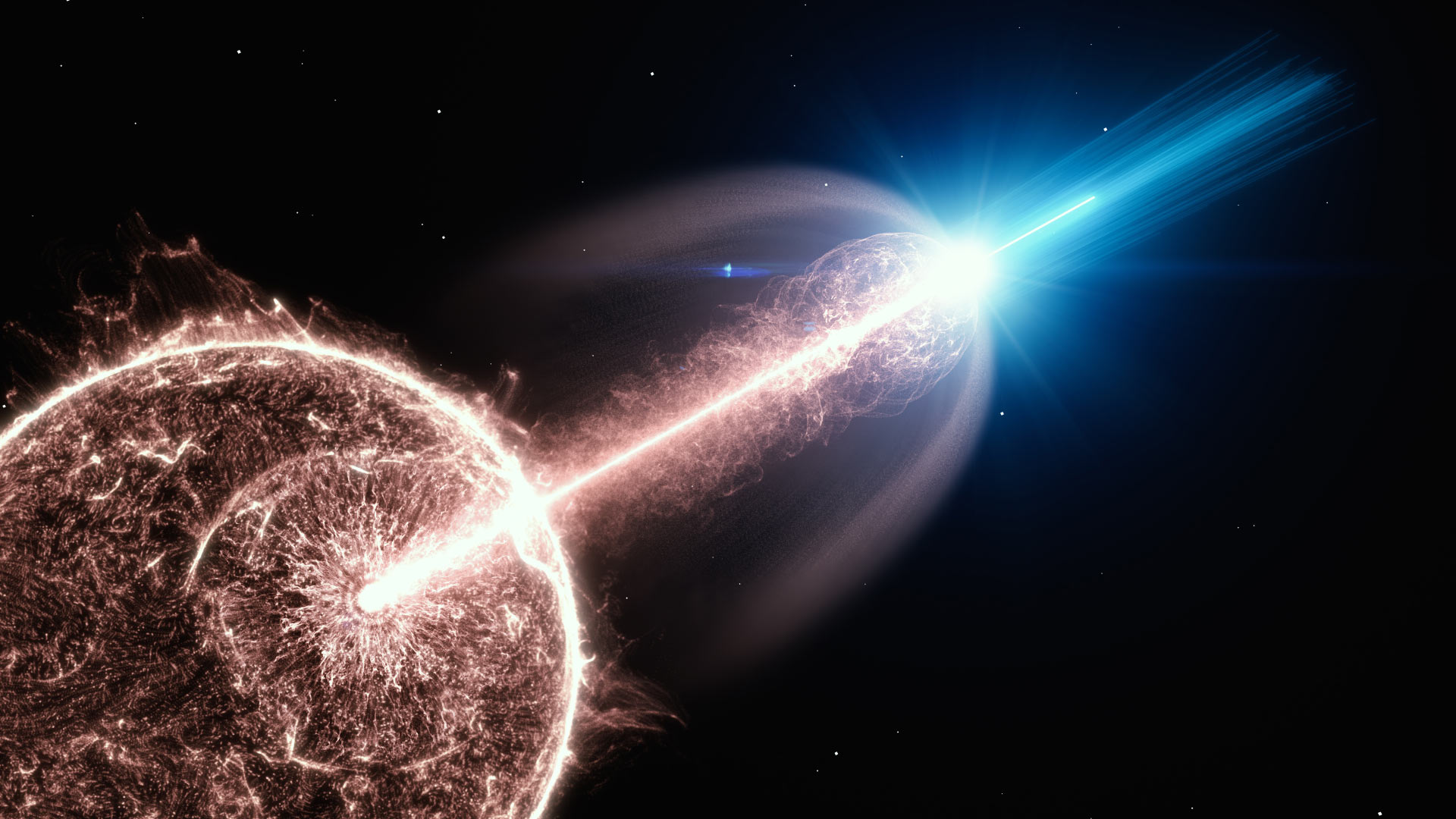

An artist's depiction of a gamma-ray burst's relativistic jet full of very-high-energy photons breaking out of a collapsing star. Credit: DESY, Science Communication Lab
Gamma-ray bursts (GRBs) are one of the most powerful phenomena in the Universe and something that astronomers have been studying furiously to learn more about their origins. In recent years, astronomers have set new records for the most powerful GRB ever observed – this includes GRB 190114C, observed by the Hubble Space Telescope in 2019, and GRB 221009A, detected by the Gemini South telescope in 2022. The same is true for high-energy cosmic rays that originate from within the Milky Way, whose origins are still not fully understood.
In a recent study, members of China’s Large High Altitude Air Shower Observatory (LHAASO) Collaboration discovered a massive gamma-ray burst (designated GRB 221009A) in the Cygnus star-forming region that was more powerful than 10 peta-electronvolts (PeV, 1PeV=1015eV), over ten times the average. In addition to being the brightest GRB studied to date, the team was able to precisely measure the energy spectrum of the burst, making this the first time astronomers have traced cosmic rays with this energy level back to their source.
The team was led by Prof. Cao Zhen, a professor at the Institute of High Energy Physics of the Chinese Academy of Sciences (CAS-IHEP), and included CAS members Dr. Gao Chuandong, Dr. Li Cong, Prof. Liu Ruoyu, and Prof. Yang Ruizhi. Their results were described in a paper titled “An ultrahigh-energy gamma-ray bubble powered by a super PeVatron,” which appeared on November 15th in Science Bulletin. The LHAASO Collaboration comprises over 280 members representing 32 astrophysics research institutions worldwide.
The Large High-Altitude Air Shower Observatory (LHAASO) is a composite array made up of 5216 electromagnetic particle detectors, 1188 muon detectors, a 78,000-square-meter water Cherenkov detector array, and 18 wide-angle Cherenkov telescopes. The observatory is located at a height of 4,410 meters (14468.5 ft) on Mount Haizi in Sichuan Province, China, and is dedicated to studying cosmic rays. When cosmic rays reach Earth’s atmosphere, they create “showers” of secondary particles, some of which reach the surface.
The origin of cosmic rays is one of the most important issues in astrophysics today. In the past few decades, astronomers have detected three high-energy GRBs at a peak of about one petaelectronvolts (PeVs) – one quadrillion electronvolts (1015eV) – in their energy spectrum. Scientists believe cosmic rays with energy beneath this level come from astrophysical sources within the Milky Way (like supernovae). This peak energy represents a limit for cosmic rays, which generally take the form of protons accelerated to near-light speed.
However, the origins of cosmic rays in the region of a few petaelectronvolts remain one of the more intriguing mysteries in astrophysics today. Based on data acquired by LHAASO, the Collaboration team discovered a giant ultra-high-energy gamma-ray bubble in the Cygnus X cluster (the largest star-forming region in the Solar neighborhood) located roughly 2.4 billion light-years from Earth. Photons detected inside the structure showed a maximum energy reading of 2.5 PeV, while those ejected showed energy values of up to 20 PeV – the highest ever recorded.
From this, the team inferred the presence of a massive cosmic ray accelerator near the center of the Bubble, which they believe to be the massive star cluster Cygnus OB2 within Cygnus X. This cluster is composed of many young massive stars, including blue-white O-type giants and B-type blue giants, with surface temperatures of over 35,000 and 15,000 °C (63,000 and 27,000 °F), respectively. These stars generate radiation pressure hundreds to millions of times that of the Sun that blows stellar surface material away, creating solar winds that move at speeds of up to thousands of kilometers per second.
Collisions between this wind and the ISM create high-energy gamma rays and the ideal environment for efficient particle acceleration. These findings represent the highest-energy cosmic rays detected to date and the first cosmic ray accelerator ever observed. The team’s observations also indicated that the accelerator significantly increases the cosmic ray density in the surrounding ISM, greatly exceeding the average level of cosmic rays in the Milky Way. Lastly, the measured background light intensity in the infrared band was much lower than expected, roughly 40% of what cosmological models suggest.
These observations challenge the standard model of GRB afterglows and could lead astronomers to rethink current models of galaxy formation and evolution. Similarly, it could provide crucial information for testing Special Relativity (SR) and the possibility that Dark Matter is composed of axions. Professor Elena Amato, an astrophysicist with the Italian National Institute for Astrophysics (INAF), indicated that these results “not only impacts our understanding of diffuse emission, but has also very relevant consequences on our description of cosmic ray (CR) transport in the Galaxy.”
Further Reading: Chinese Academy of Sciences
In 2007, astronomers discovered the Cosmic Horseshoe, a gravitationally lensed system of galaxies about five-and-a-half…
Venus differs from Earth in many ways including a lack of internal dynamo driving global…
The journey to Mars will subject astronauts to extended periods of exposure to radiation during…
Anthropogenic climate change is creating a vicious circle where rising temperatures are causing glaciers to…
Satellites often face a disappointing end: despite having fully working systems, they are often de-orbited…
Astronomers have known for some time that nearby supernovae have had a profound effect on…